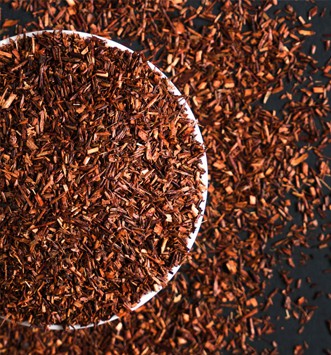
The history of rooibos begins in the Cederberg, near the Cape. Its origin dates back several hundred years. Gradually, the infusion of the reddish bush crossed borders. Incorrectly named red tea, rooibos tea is increasingly appealing to Westerners. This drink is progressively replacing classic teas and coffee due to its health benefits. Dive into the discovery of the fascinating epic of rooibos.
Rooibos, an organic infusion like no other
In the West, rooibos is often called "red tea". However, although it is an infusion, this drink is not a tea. Moreover, the term "red tea" in China refers to what Westerners call "black tea".
Unlike teas, rooibos does not contain theine. This drink also does not contain caffeine. This reddish herbal tea is nevertheless rich in antioxidants. Nature has also endowed it with many positive properties for health.
In Western countries, it is not uncommon for rooibos to be flavored with spices. They increase its flavor. Moreover, some have an effect on the benefits of the beverage.
From the bush in the Cederberg mountains to the red infusion of your snack
Rooibos only grows in the Cederberg, a mountain range north of Cape Town. The leaves of the shrub have been harvested there for over 300 years. Dried in the sun, the leaves ferment and give the infusion its pretty reddish color. Fermentation also gives the plant a sweeter and fruitier taste.
The rooibos herbal tea, completely organic, remains a traditional South African drink. It was only during the 1930s that it was clandestinely imported to wealthy Westerners. It was then a luxury herbal tea, generally served during the Christmas season. Indeed, the reddish coloration of the decoction blended well with Christmas decorations.
In 1969, the first medicinal properties of the infusion were discovered. Its benefits became popularized. The drink with reddish hues then massively arrived in European countries. Its production has exploded since the 1990s.
Today, the craze for red rooibos (there is a green variety) is stronger than ever. However, capricious nature does not allow the cultivation of the shrub anywhere other than in the aridity of the Cederberg. Rooibos has therefore become a flourishing economy for South Africa.
Aspalathus linearis, a story of traditions
For the inhabitants of Cape Town, the preparation of rooibos is above all a matter of tradition. Harvesting the leaves and drying them like their ancestors is, for many Capetonians, a matter of respecting the elders of the family.
And, although the "production" aspect is developing rapidly, Capetonians maintain this desire for tradition. In Africa, rooibos is never called tea. Moreover, the population preserves the traditional uses of the rooibos product to treat colic, sleep disorders, and allergies.
In the West, medical evidence for traditional uses is still awaited. The first studies are encouraging, but require further investigation. Indeed, the quality of rooibos is very variable depending on its origin. However, due to the absence of theine and caffeine in rooibos infusions, consumption remains encouraged. If only for the flavor of the plant.
From South Africa's national drink to spiced infusions
North of Cape Town, the mountains produce an abundance of rooibos. For a traditional preparation, Capetonians add hot water to the crushed leaves. After a 10-minute decoction, they remove the brew. In this region, it is customary to add milk and sometimes sugar.
In Europe, the recipes are quite different. Each family member has their own composition. Spices add flavor and additional benefits to the beverage.
Vanilla or cocoa flavors the children's rooibos. Adults appreciate products with ginger or lemon. Of course, medicinal plants can also be added to the brew.
The quality of Western blends varies. However, the greatest successes are:
- Plants like verbena or linden which are very useful for overcoming sleep disorders.
- Recipes with peppermint that are useful for digestion.
- Products with chamomile that relieve allergies.
For a rooibos worthy of a Capetonian, put a teaspoon of rooibos powder for a cup of hot water. The reddish color of the brew will indicate when it's ready. Spices like lemon or ginger are added later.